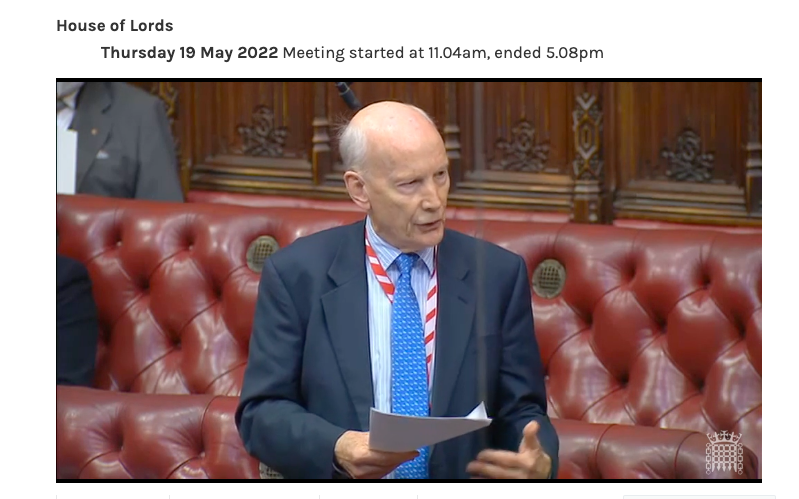
Submitted by L. Millard on Mon, 30/05/2022 - 09:33
Professor Lord Robert Mair, Founding Head of CSIC, led a debate in the House of Lords on the Science and Technology Select Committee’s report titled Catapults: Bridging the Gap between Research and Industry discussing the future of the Catapults.
Opening the debate, Lord Mair stressed the importance of the topic, saying “there is an increasingly vital need to stimulate the UK’s economy by driving innovation and investment by industry from our science and technology research”.
Funding for the Catapults
Referring to government targets for the UK to spend 2.4% of GDP on R&D by 2027, up from the current level of 1.7%, Lord Mair noted the current level of spend as “significantly lower than the average for EU countries and the average for OECD countries”. Framing the debate, Lord Mair said: “The Government have committed to increasing public sector R&D spending to £22 billion per year—about 0.8% of GDP—by 2024-25. This is very welcome. However, achieving the overall target will require significant private sector investment, which is expected to be around twice the public sector spending. The 2.4% target therefore represents a very significant increase in private sector funding, some of which is expected to arise through the Catapults' activities. The question is how to achieve this?”
It is clear that the Government rightly have strong ambitions for research and development, as set out in their R&D road map. Achieving the important 2.4% target will require substantially greater private sector investment. The key questions are: how is this to be achieved, which technology sectors will be prioritised, and what role should the Catapults play, given that they are unique national assets? Professor Lord Robert Mair, Founding Head of CSIC
Timeline
Lord Mair presented the background to the debate. The Catapults resulted from a 2010 review by Dr Hermann Hauser to bridge a critical gap between research findings and their subsequent development into commercial propositions; they were introduced to help support the UK to translate its scientific research into profitable industrial applications. The first Catapults were established in 2011 and the current network features nine Catapults . In July 2020 the Government published its R&D road map which sought to build on the UK’s innovation infrastructure, including enhancing the Catapult network.
In November 2020, the Science and Technology Committee launched its short inquiry to examine the contribution of the Catapults to delivering the UK’s R&D road map, including their role in stimulating long-term private investment and supporting new innovation tie-ups; its report was published in February 2021. This was followed by the Government’s review in April 2021, Catapult Network Review 2021: How the UK’s Catapults can Strengthen Research and Development Capacity. In the same month, the Government also published their response to the Select Committee’s report that proposed key recommendations around: reforming specific rules governing innovation funding to allow greater flexibility for Catapults and their partners; mobility between academia and industry; regional development; and the future role and long-term continuity for the Catapults .
Investment in R&D
Concluding his opening to the debate, Lord Mair summarised the issue: “It is clear that the Government rightly have strong ambitions for research and development, as set out in their R&D road map. Achieving the important 2.4% target will require substantially greater private sector investment. The key questions are: how is this to be achieved, which technology sectors will be prioritised, and what role should the Catapults play, given that they are unique national assets?”
Ministerial response
A number of Peers contributed to the debate ahead of the response by Lord Callanan, the Parliamentary Under-Secretary of State, Department for Business, Energy and Industrial Strategy (BEIS), who acknowledged that Catapults are “integral to achieving our goal of increasing our investment in R&D to 2.4% of GDP by 2027” and that UKRI has “reviewed its eligibility rules for research council funding and, from 1 June 2022, Catapults will be eligible to apply for opportunities on the same basis as independent research organisations and public sector research establishments”. Full details of the BEIS £39.8 billion R&D budget, including funding for Catapults, which will be allocated between partner organisations over the next three years will, said Lord Callanan, be “set out in due course”. He concluded: “As we look to the future, R&D will be critical to economic recovery, and Catapults are and will remain a valuable part of the UK’s innovation ecosystem, as we seek to build back better.”
Catapults are a UK national innovation asset
Closing the debate, Lord Mair thanked the Peers and the Minister for their contributions and concluded: “Catapults need to be promoted actively by the Government as a UK national innovation asset. They have a crucial role in developing technologies in which the UK excels, promoting private sector investment and supporting sectors that will bring substantial benefits to our economy.”
Quick Links
• Read the Hansard report on ‘Catapults: Science and Technology Committee Report) debated at the House of Lords on Thursday 19 May here.
• Read the response from Matthew Durdy, Chair of the Catapult Network, here.
• Read the Science and Technology Select Committee 2nd Report of Session 2019-21, ‘Catapults: bridging the gap between research and industry’ here.
